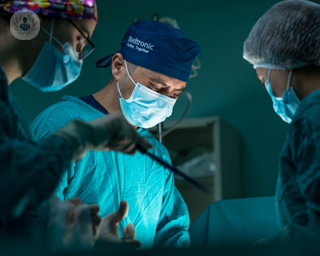What is abdominal wall reconstruction surgery?
The abdominal wall is the three layers of muscle that protect and hold the inner organs. Sometimes, the strength and thickness of these muscles can become weak and unstable, due to a number of reasons, including:
- Recurring hernias
- Open, non-healing wounds
The aim of abdominal wall reconstruction surgery is to redistribute more evenly, and hence strengthen the abdominal muscles across the abdomen, giving the patient more comfort and an improved look to the abdomen as well.

Why would you do it?
This treatment option is often a final option, when other procedures have been unsuccessful. The main objective of this surgery is to restore strength and stability of the abdominal wall, giving it the ability to tolerate physical activity.
Most frequently, this surgery is required to fix recurring abdominal hernias. Generally, an abdominal hernia happens when the abdominal muscles become too weak, and as a result, the muscles split apart. This can result in fatty tissue and some of the bowel to protrude onto these muscles, causing swelling.
The types of abdominal hernia that can cause this are:
- Often developing near an old scar, fatty tissue and a section of bowel protrude through the weakened muscles after surgery.
- Part of the bowel or protrudes through the umbilical opening in the abdominal muscles.
- Although this type of hernia generally occurs in babies and infants, adults can be affected too, particularly in women after pregnancy.
What does this surgery involve?
During surgery, an incision into the abdomen is made and the layers of muscle are moved and redistributed. This allows the abdominal wall to closely return to its natural configuration.
Often in abdominal wall reconstruction surgery, a bioprosthetic mesh is used to reinforce the new positioning of the abdominal muscles. This mesh is made out of animal tissue allowing it to eventually be incorporated into the body. Using animal tissue has a lower risk of infection than if synthetic materials were used instead.
How to prepare for it
Like any other surgical procedure, before this treatment is recommended, a thorough examination will be conducted, with any relevant tests being carried out too. In addition, it may be necessary to cease eating and drinking the day of surgery.
Post-operative care
Those undergoing abdominal wall reconstructive surgery generally have to stay in hospital for up to five days following the procedure, or at least until bowel functions return to normal. You will also have drains attached to the site of surgery, to allow any fluids produced to be released. It may also be necessary to wear an abdominal binder after surgery for up to a month whilst the body heals.
11-13-2012 09-14-2023Abdominal wall reconstruction
What is abdominal wall reconstruction surgery?
The abdominal wall is the three layers of muscle that protect and hold the inner organs. Sometimes, the strength and thickness of these muscles can become weak and unstable, due to a number of reasons, including:
- Recurring hernias
- Open, non-healing wounds
The aim of abdominal wall reconstruction surgery is to redistribute more evenly, and hence strengthen the abdominal muscles across the abdomen, giving the patient more comfort and an improved look to the abdomen as well.

Why would you do it?
This treatment option is often a final option, when other procedures have been unsuccessful. The main objective of this surgery is to restore strength and stability of the abdominal wall, giving it the ability to tolerate physical activity.
Most frequently, this surgery is required to fix recurring abdominal hernias. Generally, an abdominal hernia happens when the abdominal muscles become too weak, and as a result, the muscles split apart. This can result in fatty tissue and some of the bowel to protrude onto these muscles, causing swelling.
The types of abdominal hernia that can cause this are:
- Often developing near an old scar, fatty tissue and a section of bowel protrude through the weakened muscles after surgery.
- Part of the bowel or protrudes through the umbilical opening in the abdominal muscles.
- Although this type of hernia generally occurs in babies and infants, adults can be affected too, particularly in women after pregnancy.
What does this surgery involve?
During surgery, an incision into the abdomen is made and the layers of muscle are moved and redistributed. This allows the abdominal wall to closely return to its natural configuration.
Often in abdominal wall reconstruction surgery, a bioprosthetic mesh is used to reinforce the new positioning of the abdominal muscles. This mesh is made out of animal tissue allowing it to eventually be incorporated into the body. Using animal tissue has a lower risk of infection than if synthetic materials were used instead.
How to prepare for it
Like any other surgical procedure, before this treatment is recommended, a thorough examination will be conducted, with any relevant tests being carried out too. In addition, it may be necessary to cease eating and drinking the day of surgery.
Post-operative care
Those undergoing abdominal wall reconstructive surgery generally have to stay in hospital for up to five days following the procedure, or at least until bowel functions return to normal. You will also have drains attached to the site of surgery, to allow any fluids produced to be released. It may also be necessary to wear an abdominal binder after surgery for up to a month whilst the body heals.


Epigastric hernia: When is surgery required?
By Mr Filippo Di Franco
2024-11-21
Leading consultant general surgeon Mr Filippo Di Franco gives an expert guide to the symptoms and treatment of epigastric hernias, including when surgery is indicated. See more


What to expect from repair surgery for complex abdominal wall hernia
By Miss Jasdeep Gahir
2024-11-20
Highly respected consultant oncoplastic and general surgeon Miss Jasdeep Gahir gives an in-depth guide to complex abdominal wall hernia repair surgery in this informative guide for patients. See more


How will they repair my hernia? Surgical options available
By Mr Sabu Jacob
2024-11-20
Mr Sabu Jacob, one of our top general and vascular surgeons based in Brentwood and Essex, explains to us the two types of surgical procedures available to treat a hernia, which one is more effective and exactly what a tension-free mesh hernia repair involves. See more


An expert guide: How to prepare for complex abdominal wall reconstruction surgery
By Mr Colin Hart
2024-11-20
Leading consultant general, colorectal and emergency surgeon Mr Colin Hart gives a detailed guide to complex abdominal wall repair surgery in this informative article. See more
Experts in Abdominal wall reconstruction
-
Mr Joseph Varghese
SurgeryExpert in:
- Cholecystectomy
- Hernia
- Endoscopy
- Colonoscopy
- Therapeutic endoscopic retrograde cholangiopancreatography (ERCP)
- Abdominal wall reconstruction
-
Mr Eriberto Farinella
SurgeryExpert in:
- Abdominal pain
- Laparoscopy
- Abdominal wall reconstruction
- Hernia
- Cholelithiasis (gallstones)
- Rectal surgery
-
Mr Georgios Pafitanis
Plastic surgeryExpert in:
- Abdominal wall reconstruction
- Head and neck cancer
- Facial reconstruction
- Limb Surgery
- Microsurgery
- Tummy tuck (abdominoplasty)
-
Mr Arjun Shankar
SurgeryExpert in:
- Gastrointestinal endoscopy
- Sarcoma
- Pancreatitis
- Hernia
- Abdominal wall reconstruction
- Gallbladder surgery
-
Mr Aimen Amer
SurgeryExpert in:
- Liver transplant
- Kidney transplantation
- Gallbladder surgery
- Inguinal hernia
- Incisional hernia
- Abdominal wall reconstruction
- See all

The Harley Street Clinic - part of HCA Healthcare
The Harley Street Clinic - part of HCA Healthcare
35 Weymouth Street, London. W1G 8BJ
No existe teléfono en el centro.
By using the telephone number provided by TOP DOCTORS, you automatically agree to let us use your phone number for statistical and commercial purposes. For further information, read our Privacy Policy
Top Doctors

Specialists in Plastic Surgery
Specialists in Plastic Surgery
5 Devonshire Place
No existe teléfono en el centro.
By using the telephone number provided by TOP DOCTORS, you automatically agree to let us use your phone number for statistical and commercial purposes. For further information, read our Privacy Policy
Top Doctors

New Victoria Hospital
New Victoria Hospital
184 Coombe Lane West, Kingston upon Thames, KT2 7EG
No existe teléfono en el centro.
By using the telephone number provided by TOP DOCTORS, you automatically agree to let us use your phone number for statistical and commercial purposes. For further information, read our Privacy Policy
Top Doctors
-
The Harley Street Clinic - part of HCA Healthcare
35 Weymouth Street, London. W1G 8BJ, Central LondonExpert in:
- Cancer
- Head and neck cancer
- Cardiology
- Intensive care
- Diagnostic Imaging
- Women’s health
-
Specialists in Plastic Surgery
5 Devonshire Place, W1G Marylebone LondonExpert in:
- Abdominoplasty
- Blepharoplasty
- Breast augmentation
- Facelift
- Liposuction
- Breast reduction
-
New Victoria Hospital
184 Coombe Lane West, Kingston upon Thames, KT2 7EG, South LondonExpert in:
- Cardiology
- General Surgery
- Orthopaedic surgery
- Breast augmentation
- Pain management
- Spine
- See all
- Most viewed diseases, medical tests, and treatments
- Migraine
- Weight loss injections
- Nipple discharge
- Abdominal pain
- Endovenous laser treatment (EVLA)
- Minimal access surgery (keyhole surgery)
- Head and neck cancer
- Neck lump
- Bariatric surgery
- Acellular dermal matrix (ADM)








